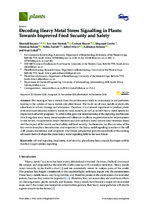| dc.description.abstract | The mining of heavy metals from the environment leads to an increase in soil pollution, leading to the uptake of heavy metals into plant tissue. The build-up of toxic metals in plant cells often leads to cellular damage and senescence. Therefore, it is of utmost importance to produce plants with improved tolerance to heavy metals for food security, as well as to limit heavy metal uptake for improved food safety purposes. To achieve this goal, our understanding of the signaling mechanisms which regulate toxic heavy metal uptake and tolerance in plants requires extensive improvement. In this review, we summarize recent literature and data on heavy metal toxicity (oral reference doses) and the impact of the metals on food safety and food security. Furthermore, we discuss some of the key events (reception, transduction, and response) in the heavy metal signaling cascades in the cell wall, plasma membrane, and cytoplasm. Our future perspectives provide an outlook of the exciting advances that will shape the plant heavy metal signaling field in the near future. | en_US |

